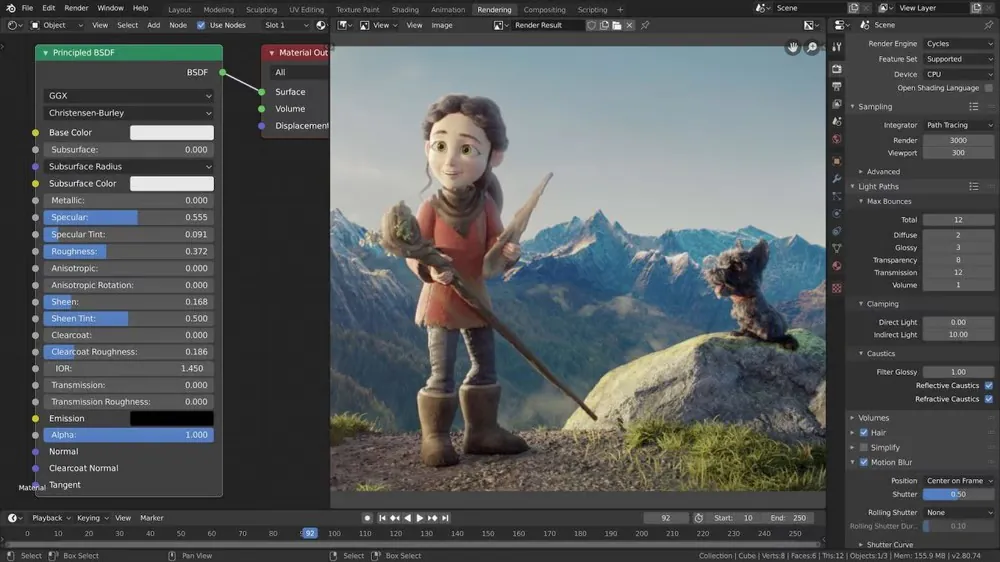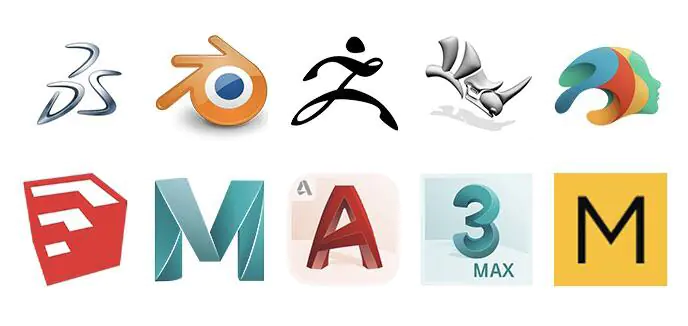
3D Digital Sculpting For Character Design And Animation
Digital sculpting has revolutionized the way character designers and animators approach their craft. With the help of this technology, artists and animators can create highly detailed and realistic, three-dimensional models of characters using specialized software. It has created a whole new realm of creative opportunities and made it feasible for artists to achieve their visions. Traditionally, clay or plaster was used for traditional sculpting techniques such as character creation and animation. Although they are still widely used, digital sculpting has a number of benefits over conventional techniques. A potential advantage is that it enables quicker and more effective work for artists. Making changes rather than starting over each time is fast and simple. Furthermore, digital sculpting provides a degree of accuracy that is challenging with conventional techniques. This blog will delve into digital sculpting for animation and character design. We will look at the various digital sculpting software available, and the techniques artists and animators use to create lifelike 3D models. We will also provide tips and tricks for artists looking to improve their digital sculpting skills.
Digital Sculpting Software:
Various digital sculpting software is available in the market, each with unique features and benefits. Here are some of the most popular digital sculpting software:
ZBrush: ZBrush is considered one of the best digital sculpting software in the market. It has a user-friendly interface and a wide range of features, making it easier for artists to create highly detailed 3D models. ZBrush allows users to sculpt using a range of brushes, masks, and layers. It also has a unique ZRemesher feature that allows artists to quickly and easily create a clean model topology. ZBrush is widely used in the film, gaming, and animation industries.
Mudbox: Mudbox is another popular digital sculpting software used in the film and gaming industries. It has powerful sculpting tools and allows artists to work with high-resolution textures. Mudbox has various features for creating realistic lighting and shadows, allowing users to work with multiple materials. The software also has an intuitive user interface and is easy to learn.
Blender: Blender is an open-source digital sculpting software for hobbyists and professional artists. It is known for its versatility and range of features. Blender has many sculpting tools, including brushes, layers, and masks. It also has various features for creating animations, including rigging and keyframe animation. Blender is a popular choice for creating 3D models for video games and visual effects.
Autodesk Maya: Autodesk Maya is a powerful digital sculpting software in 3D modelling, animation, and VFX workflows. It offers advanced tools for creating complex 3D models and animations, including character designs, architectural visualizations, and product prototypes. The software is widely used in the entertainment industry and is favored by artists for its intuitive user interface and flexible workflow.
3D-Coat: 3D-Coat is a digital sculpting software that allows artists to create highly detailed 3D models. It has a range of sculpting tools and allows users to work with multiple materials. The software also has various features for creating realistic textures, including a built-in painting engine. 3D-Coat is used in the film, gaming, and animation industries.
Sculptris: Sculptris is a free digital sculpting software that is easy to learn and use. It has a range of sculpting tools, including brushes and layers. Sculptris is popular for beginners and hobbyists who want to learn digital sculpting.
Techniques Used in Digital Sculpting:
There are several techniques used in 3D digital sculpting for character design and animation, and here we discuss some of the most common techniques.
Clay Modeling
The clay modelling technique is one of the oldest methods used in 3D sculpting. It involves sculpting tools to shape a virtual lump of clay into a character’s shape. This method is usually the first step in character design, and most 3D software programs have a feature that simulates the feel of clay.
Box Modeling
Box modelling technique is polygonal modelling, which involves starting with a simple mesh shape and refining it to create the final character. This technique is often used for creating human characters or creatures with smooth, flowing shapes.
Vertex Modeling
Vertex modelling is another popular technique used in 3D sculpting. This method involves manipulating individual points or vertices to shape the character. It is especially useful for detailed work, such as creating facial expressions or wrinkles.
Sculpting Brushes
Sculpting brushes are popular 3D sculpting tools used to create realistic details on a character’s surface. They are digital versions of traditional sculpting tools, enabling digital artists to create intricate details, such as skin texture, wrinkles, and pores.
Retopology
Retopology is creating a new mesh over an existing one. This technique is particularly useful for Creating a mesh that will deform correctly when animated.
UV Mapping
UV mapping is mapping a 2D texture onto a 3D surface. This technique is essential for creating realistic textures on a character’s surface, detailed skins or clothing. It involves unwrapping the 3D model into a flat, 2D shape that can be layered with a texture map.
Texturing
Texturing involves adding detail to the character’s surface with textures. It involves painting textures onto the character mesh using a digital painting program. It can add many details to a character, such as creating realistic skin and hair textures.
Rigging
Rigging involves creating a skeleton for the character, which enables animators to move the character’s limbs and features. This process involves adding bones to the character’s mesh and binding them to the character so that they move with it. Rigging is essential for animating characters, and it can be a very time-consuming process.
Animation
Animation is the final step in the 3D digital sculpting process. It involves creating keyframes that enable the characters to move realistically.
Reference Images
Reference images are essential when creating 3D models of characters and objects. They provide a visual guide for artists to follow and help them create more accurate and realistic models.
Blocking Out
Blocking out is creating a basic shape of the character or object using simple geometric shapes that establish the overall form and proportion of the model before adding details.
Benefits:
1. Realistic 3D models: Digital sculpting allows artists to create highly realistic 3D models with fine details and complex shapes that are difficult to achieve with traditional sculpting methods.
2. Time-efficient: Digital sculpting can save a lot of time for artists, as it eliminates the need for physical materials, such as clay or stone, and the time-consuming process of mold-making and casting.
3. Flexibility: Digital sculpting allows artists to change their work at any point without starting from scratch. It also allows them to try different materials, colors, and lighting to see how the final piece will look.
4. Collaboration: Artists can collaborate easily by sharing digital files, which can be edited and worked on simultaneously by multiple people across different locations.
Challenges:
1. Learning Curve: Digital sculpting is a complex process that requires specialized software and technical expertise. Artists may need to invest significant time and resources to become proficient in the software and tools.
2. Cost: Digital sculpting requires powerful computer hardware and software, which can be expensive. Additionally, artists may face ongoing costs for upgrades and updates to keep pace with technological changes.
3. Lack of Physicality: Digital sculpting eliminates the tactile experience of traditional sculpting, which some artists may find limiting.
4. Limited Tools: While digital sculpting offers a variety of advanced tools, they may only be suitable for some types of sculpting, such as large-scale pieces or those that require special materials.
Some useful tips to help artists improve their digital sculpting skills:
Start practising with basic shapes: Before diving into complex sculptures, practice with simple shapes like a sphere, cube, or cylinder. It will help you gain mastery over the sculpting tools and techniques and develop your muscle memory to use them more efficiently.
Study anatomy: Understanding human and animal anatomy is crucial for creating realistic digital sculptures. Study books on anatomy, attend life drawing classes, and observe real-life subjects to improve your understanding of proportions, skeletal structure, and musculature.
Experiment with different sculpting software: There are multiple software options available for digital sculptings, such as ZBrush, Blender, and Mudbox. Experimenting with different software helps to find one that fits your style.
Use reference images: Always refer to real-life references or photographs while creating digital sculptures, ensuring that proportions, anatomy, and other details are accurate.
Break down complex shapes into simpler elements: Complex shapes, like rocks, buildings, etc., can be broken down into simpler forms to create a more accurate and realistic end product.
Join digital sculpting communities: Joining online communities of artists who share your passion for digital sculpting can help keep you motivated, offer constructive feedback, and provide tips and tricks to improve your craft.
Keep experimenting and learning: Always experiment with different approaches and techniques to improve your skills. Watch tutorials, attend workshops, and stay updated with the latest trends and technology in digital sculpting.
Conclusion:
In conclusion, 3D digital sculpting for character design and animation allows artists to easily and flexibly create highly complex and realistic characters. With the rise of digital media, the demand for skilled 3D artists continues to grow. We can expect even more innovative and efficient digital sculpting tools as technology advances.




